Uranus and Neptune
Of the two outer gas giants, it is Neptune that is by far the most favourably placed for observation during May.
Uranus is to be found alongside Jupiter in the evening sky on the Aries/Taurus borders at the early part of the month. While Jupiter, being very bright at -2.0 magnitude, will still be observable at this time, the much fainter Uranus - at +5.8 magnitude - won’t be. The planet is headed rapidly sunwards and will reach superior conjunction on May 13th, so will be unobservable for most of the month. It is a rough rule of thumb that Uranus is difficult, if not impossible to be observed within 20° of the Sun. When you consider that the planet is found around 10 1/2° from our parent star at the beginning of May, it is will come as no surprise that Uranus will be unobservable at this time. After superior conjunction, Uranus will begin to become a morning target, though it will be further into June before the planet can be observed again. Uranus ends May alongside Mercury in Taurus and will still only be just over 16° separation from the Sun.
Neptune, on the other hand is in a much better position to be observed. As a morning target, the planets sits at around 42° separation from the Sun on the morning of the 1st of May, in the constellation of Pisces.
Neptune is generally believed to be unobservable at less than 22° from the Sun, so at nearly twice this, the planet should be a reasonable target for those with telescopes and binoculars. Though at +7.9 magnitude, observers will have to contend with steadily lightening skies, especially as the month progresses, which will make finding the planet a little more challenging.
By the time we reach the end of May, Neptune is no brighter, but will have increased its separation from the Sun to over 70° and can now be found around 10 1/2° from Saturn (in an easterly direction) in the morning sky. It will rise at a little after 2:40 am (BST) and will stand at just under 21 1/2° above the horizon (from 51° north) as the Sun rises.
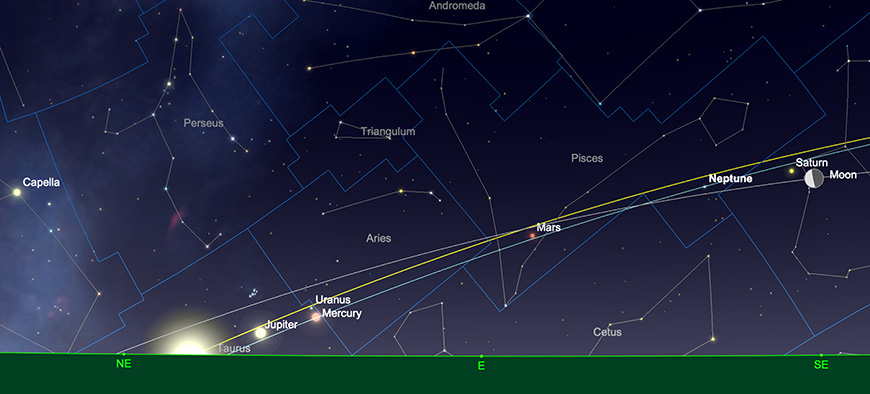
Uranus and Neptune relative positions, sunrise 31st May. Image created with SkySafari 6 for Mac OS X, ©2010-2016 Simulation Curriculum Corp., skysafariastronomy.com.
Comets
12P/Pons-Brooks has put on fine showing in the evening sky over the past couple of months and at time of writing is around magnitude 4.5 to 5. The Comet is heading south and is to be found in the southern part of Taurus as May begins. Sadly, by this point in time the comet will be setting almost in line with the Sun and while maintaining reasonable brightness, will be nigh on impossible to observe from higher northern latitudes. Those in the southern hemisphere and equatorial regions of the Earth will fare considerably better in this respect, with the comet appearing much higher in the sky at sunset. The comet reached perihelion in late April, so is now headed outwards from the Sun and it should maintain reasonable brightness for a while yet, will slowly start fade as it proceeds from the Sun. By the end of May, 12P will have headed down through Taurus and Eridanus and will be found in Lepis, the Hare. Sadly, for most observers in the northern hemisphere will be completely invisible at this time, though again, observers in the southern hemisphere will still be able to see the comet in reasonable separation from their respective horizons. As 12P has a period of around 71 years it will not return to the inner system until 2095.
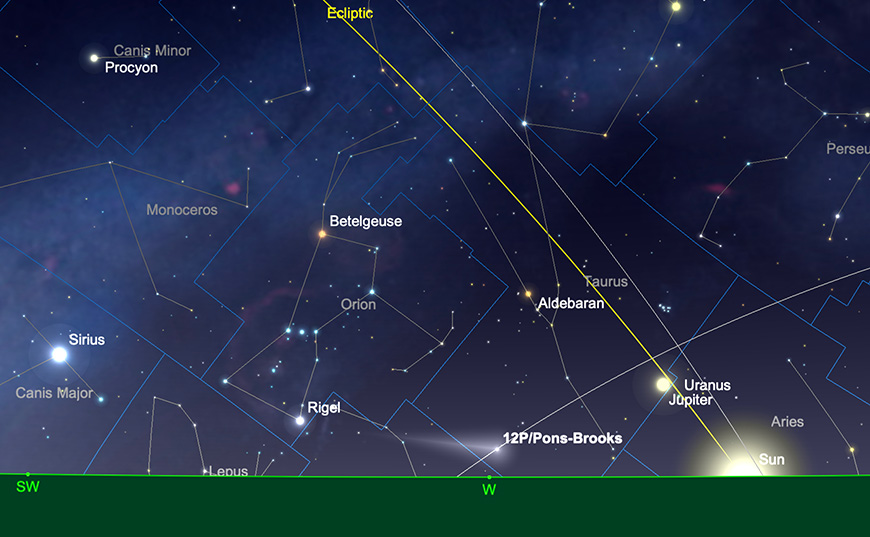
Comet Pons-Brooks position, sunset 1st May. Image created with SkySafari 6 for Mac OS X, ©2010-2016 Simulation Curriculum Corp., skysafariastronomy.com.
Another periodic comment that is an evening object during May is 13/P Olbers. This comet is around 10th magnitude at time of writing and is not expected to be especially bright during May, but will be moving in a north easterly direction from Taurus on into Auriga. The comet is expected to brighten some more from June onwards and may reach around 7th magnitude. Like 12/P, Comet Olbers has orbital period of around 70 years.
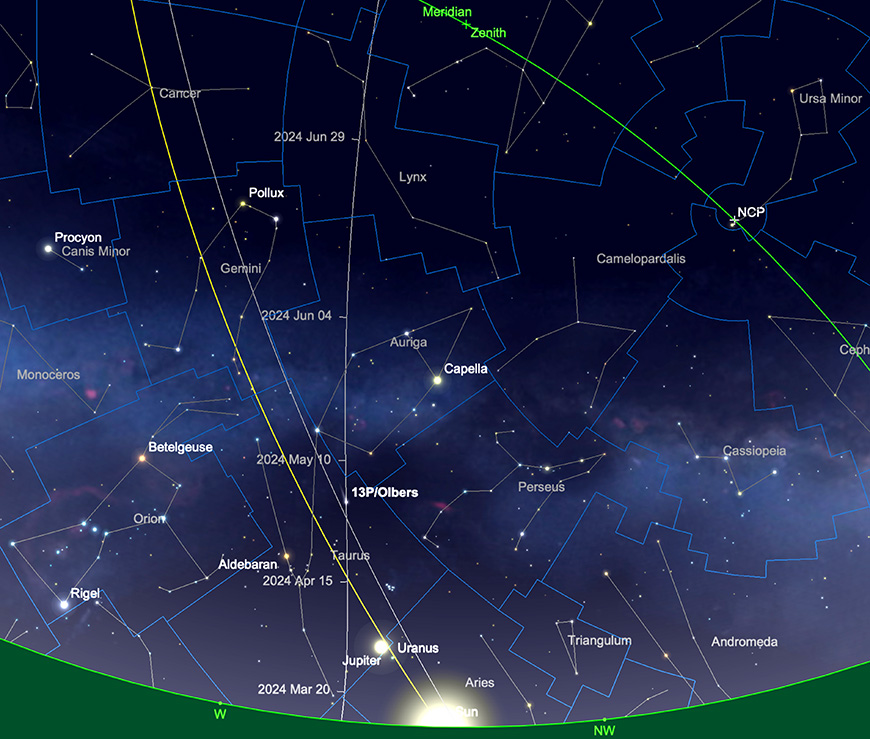
Comet Olbers path during May 2024 - comet position shown at sunset 1st May. Image created with SkySafari 6 for Mac OS X, ©2010-2016 Simulation Curriculum Corp., skysafariastronomy.com.
We are still monitoring the progress of C/2023 A3 (Tsuchinshan-ATLAS). Currently found in the constellation of Virgo at around 10th magnitude, it is predicted that this comet should get to visual range, peaking at around magnitude +0 to +1 (possibly making minus magnitudes) later on this year. This would put it in a similar brightness profile to Comet C/2020 F3 (NEOWISE). The comet is tracking through Virgo during May and June, crossing over the border into Leo in mid-June, after which it starts to head south before “doglegging” back in an easterly direction, around perihelion in September of this year. At this time, it is hoped to be around 1st magnitude, possibly higher. The comet will be a morning target at this time.
From around mid-October, C/2023 A3 will appear in the evening sky, rising up through Virgo, Serpens and on into Ophiuchus. Post perihelion, comets are traditionally more active, so it will be interesting to see if C2000 23 A3 behaves in an archetypal fashion. However, without wishing to put a damper on the excitement, we remind readers that comets are extremely unpredictable and can often disappoint. However, this particular comet certainly seems to have all the makings of a very interesting object.
Meteors
The Eta Aquariids, fueled by the famous Halley’s Comet, take centre stage, peaking on 6th May. This shower typically exhibits modest peak Zenithal Hourly Rates, reaching approximately 20 meteors per hour, though occasionally surpassing this rate threefold.
This year, the Moon is positioned almost perfectly out of the action at just a couple of days before New, during the Eta Aquariids' peak, creating optimal conditions for observation and photography. The radiant rises shortly after 2.30 am, leading to the common observation that the shower is better observed from the Southern Hemisphere, where the radiant reaches higher elevations above the horizon.
Nevertheless, meteors can be seen in any part of the sky, diverging from their radiant source, so those of us in the northern hemisphere need not be discouraged.
Deep Sky Delights: Galaxy Season Part 2 - Leo
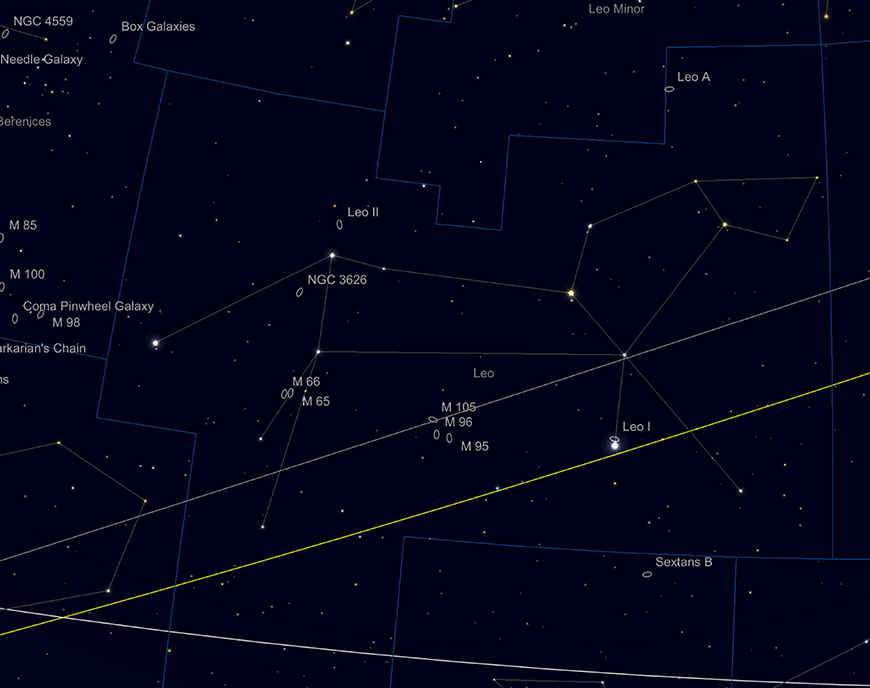
The galaxy-rich constellation of Leo. Image created with SkySafari 5 for Mac OS X, ©2010-2016 Simulation Curriculum Corp., skysafariastronomy.com.
When gazing towards Leo, there can be little doubt we are now in the part of the year known as "Galaxy Season", as this area of sky is littered with them. Galaxy hunting is not solely the preserve of those with the supposedly prerequisite "Big Dob". Although to see much in the way of detail in many of the objects mentioned this month, aperture will certainly help, a good deal of these can be seen with smaller telescopes and large binoculars from decent, dark observing sites. However, patience and care will be needed to pick the faint glow of these fantastically distant objects from the background sky. However, to discern structure in many of the galaxies we will cover requires one of two things: a large telescope of at least 10-inches of aperture (preferably more), or reliance on accurate, autoguided long-duration exposure astrophotography. To appreciate the true beauty of these massive, yet seemingly delicate structures, you need one or the other - though their location and observation (yet again), will largely be down to sky conditions - with galaxies, the darker the better! Careful, gentle filtration will help with galaxy observation from more light polluted environments, but narrowband filters like the OIII, H-Alpha and others will rarely help as much for galaxy observation as they do for nebulous objects (except when a galaxy has particular emission regions, peculiar to these wavelengths of light). A good Skyglow, CLS or broader "Deep Sky" filter will help increase the contrast of an object against the background sky, without cutting off many of the useful wavelengths that the galaxy is transmitting on. A galaxy's spectral output is much broader than typical nebulosity, so gentle filtration produces the best results.
The first object on the list for observation is one of the most difficult to see, but probably one of the simplest to locate and the closest, galaxy-wise - the Leo I galaxy. Leo I sits a third of a degree north of Regulus, Alpha Leonis - the principle star of Leo (though some publications rate it as closer). Leo I is an elliptical galaxy of reasonable angular size (12 x 8.5 arc minutes) and of photographic magnitude +11.15. Leo I is a one of its furthest satellite galaxies of our own Milky Way, lying just over 800,000 light years from us. Leo I was first detected in the Palomar Sky Survey, taken with the observatory's 48-inch Schmidt Camera in 1950. Leo I's visual magnitude is deemed to be around +9.8 mag, which should put it easily within the reach of amateur instruments. However, Leo I's easy-to-find location is also its potential downfall from a visual perspective: it lies so close to Regulus that the neighbouring galaxy is almost drowned out by its glare. There are reports of the galaxy being found in 10-12-inch class telescopes, but it is very likely that an observer would have to place Regulus just outside of the field of view, using appropriate magnification, in order to see our galaxy's most distant satellite at all. Leo I will appear as a misty oval of light, with no great discernible structure even in large telescopes. The galaxy appears to have no attendant globular clusters and contains few stars of advanced metallicity, meaning the stellar population is comparatively young - probably little over twice the age of the Sun. The galaxy is surrounded by a halo of attendant gas, which it may (or may not) have formed from.
This unusual object will be a challenge, but if found, you will be witnessing the furthest reaches of our own galaxy's orbital sphere of influence and in all likelihood its youngest attendant.
Roughly nine degrees east of Leo I lie a spectacular grouping of galaxies: the Messier objects M95, 96 and 105 (and its attendant galaxies NGC 3377 and NGC3384). This group occupies a compact area of sky (about 3 x 1.5 degrees of sky) and can be found halfway on a line drawn between Regulus and Iota Leonis - one of the rear legs of Leo. Of the three galaxies, the beautiful M95 is the most Westerly. M95 is a barred spiral galaxy, placed almost face-on from our perspective. M95 was discovered - along with the nearby M96 - in 1781, by Pierre Mechain. Messier catalogued both objects less than a week after Mechain found them. At +9.69 mag, M95 is a relatively easy, compact object at 7.4 x 5 arc minutes in dimension. Lying 31 million light years away from us, it is the closest of its group by a million light years. As M95 is a barred spiral, it is likely that most observers with decent-sized telescopes will see the galaxy's central core region as a slightly elongated object, surrounded by a fainter haze of its arms. Long duration images of the system reveal its structure in all its glory - the two massive spiral arms shedding stars into further outlying feathered lesser arms. If, as it has been suggested, our own galaxy is a barred spiral, it could look much akin to M95 to outside observers, though our galaxy may have more in the way of outlying spiral structure in its arms.
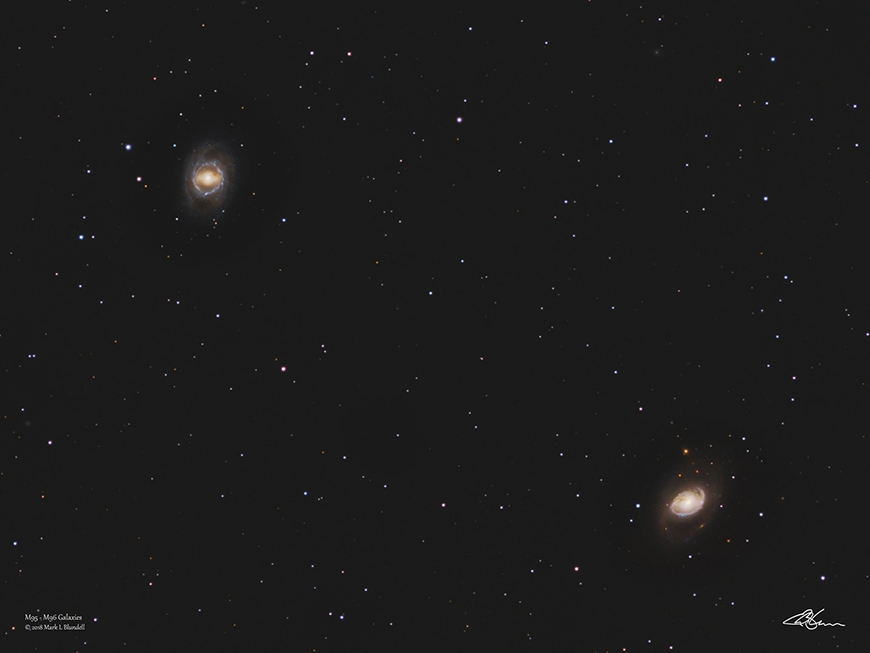
M95 and M96 by Mark Blundell. Image reproduced by kind permission.
Next door to M95 by a mere two-thirds of a degree is another lovely spiral, M96. A similar angular size to its neighbour, it is slightly brighter at +9.3 mag. In contrast to M95, M96 appears to be dustier, but has a more compact core. It is often listed as a double barred spiral. This double barring, along with the wide spread of its arms and the galaxy's dusty nature make its spiral structure less well-defined than its neighbour M95's. Similar in angular size to M95, at 7.8 x 5.2 arc minutes, M96 appears as a more compact 3 x 5 arc minute object in a 10-12-inch-class telescope, its bright central core surrounded by a fainter ring of starlight which make up its arms. The reason it also appears slightly brighter than M95 in some listings is that the galaxy is considerably foreshortened in comparison to its neighbour. Some listings incline it as much as 53 degrees to our line of site, whereas M96 is also recorded as being at a less extreme 35 degrees! Whichever listing is correct, M96 is a great target for visual and photographic observations.
Just under a degree to the north of M96 sits the grouping of M105 and the nearby NGC 3384 and 3389. Of the three, M105 is the dominant and brightest at +9.3 mag. It is often described as the analogue of Elliptical galaxies - and as such is much studied. M105 is a later addition to the Messier list (added by 20th Century Astronomer Helen Sawyer Hogg), though discovered in 1781 by Mechain, Charles Messier did not confirm its discovery at the time and it was left out of his original listing. It's difficult to understand why Messier chose not to include M105, as it is prominent enough - a misty patch of light in small telescopes and a condensed glow, with a healthy-size core in larger instruments. Elliptical galaxies, but their nature are not generally thought to be as beautiful or as characterful as their spiral counterparts, but this should not put observers off trying to locate M105. Indeed, many Astronomers now consider Elliptical galaxies to be the ultimate evolution of galaxial structure after two spirals merge - the end result of the Milky Way's potential meeting with M31 may well result in a similar structure to M105. A clue to M105's past is that it contains few areas of star formation and a reasonably elderly stellar population, suggesting it is a more advanced galaxy in terms of age.
The second Elliptical in this close trio, NGC 3384, 7 arc minutes to the NE of M105, is almost as conspicuous as its neighbour at +9.89 mag, but is presented to us at a much more oblique angle. Appearing elongated, even in small telescopes, larger instruments can reveal a clear, bright core and the misty halo of NGC 3384's outer regions. So easy is it in comparison and proximity to M105, it is difficult to believe that Mechain and Messier overlooked it. William Herschel discovered it in 1784. Although listed as the catch-all description of an elliptical galaxy, the more precise description of NGC 3384 should be as a Lenticular. The galaxy has revealed a central bar structure in long duration astrophotography and like M105 shows an older star population than the mean average.
NGC 3389 is the most challenging of this trio to observe - whereas the two previously-mentioned ellipticals are bright and their structure obvious, NGC3389 is a whole two magnitudes fainter than either at +11.89 mag and much more the visual preserve of larger telescopes. NGC 3389 is a spiral galaxy and shows a much more blue, energetic cast in long duration images (maybe somewhat reminiscent of a mini M33). This is largely due to its disassociation with the group - although close in angular proximity to M105 and NGC 3384, NGC 3389 actually lies round 64 million light years distance, roughly twice that of its neighbours and has no connection to them. Instruments of the 10-inch+ range will show it, though it will be a struggle to observe in less powerful scopes. It appears as a pale misty patch to the SE of NGC 3384 and little detail is to be expected in most telescopes, though those owning larger instruments have reported a certain textured "lumpiness" to its appearance in the eyepiece.
At low power (sub x40) it is possible to squeeze M96, M105 and NGC3384 in the same eyepiece, as it is also possible to do with M95 and M96 - though owners of low focal ratio reflectors should be advised that it is often inadvisable to attempt to use such low magnifications, lest the shadow of the secondary mirror interfere with the view.
Leaving this group of galaxies aside, we return to the aforementioned Iota Leonis and trace a line back up one of the rear "legs" of Leo, until we come across the +3.34 mag star Chertan or Theta Leonis (sometimes known as Chort or Coxa). Tracing the line back to Iota Leonis, stop approximately halfway: here is location of the next group of galaxies, the M65 Triplet, more commonly known simply as the Leo Triplet. This triplet contains the Messier objects M65 and 66 and the elongated NGC 3628. All three objects are spiral structures, though unsurprisingly they present themselves to us in differing aspects.
M65 and 66 were discovered by Charles Messier in 1780, though their discovery is often misattributed to Mechain. Of the two, M65 is slightly smaller and fainter at + 9.30 mag. It has a bright central bulge and pretty luminous arms. Presented at a significant incline to our perspective, occupying an area of 9.8 x 2.9 arc minutes, M64 also features noticeable dusky lanes within its arms, though these may well be made more prominent by foreshortening. M66, on the other hand, is a broader barred spiral, brighter than its neighbour at +8.9 mag and taking up more area in the sky at 9.1 x 4.1 arc minutes. M66's spiral arms are not as regular as M65's, which seems to suggest total interactions with neighbouring NGC 3628 in the past, as does a displaced cloud of hydrogen, which has moved outwards, from its arms and now sits, motionless, around its galactic halo.
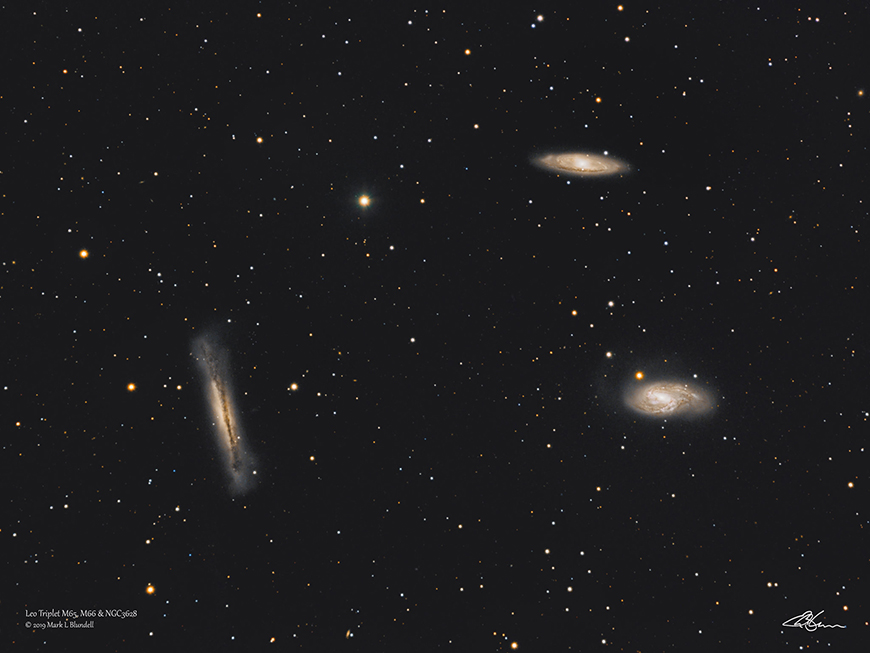
The Leo Triplet: M65, M66 and NGC3628, by Mark Blundell. Image reproduced by kind permission.
NGC 3628 is the faintest of the three at +9.50 mag and the longest at 13.1 x 3.1 arc minutes in dimensions. This is a fascinating spiral, which is presented edge on to us and is bisected through its centre by a long, dark dust lane. This is difficult in smaller telescopes, but becomes extremely prominent in larger telescopes. 10-12-inches of aperture will show it well, but in a telescope of 14-16-inches of aperture, it is unmistakable (in a similar way to NGC 891). Discovered by William Herschel in 1784, NGC 3628 is pretty obvious in relation to its neighbours, so again, it is mysterious why it wasn't discovered earlier. NGC 3628 has tidally interacted with M66, which has lead to a huge stream of stars breaking away in a staggering 300,000 light year long trail. This feature is only apparent in very long and well-processed astrophotographs, but is amongst the most spectacular and extreme pieces of evidence for gravitational interaction amongst galaxies in the sky.
All three galaxies can sit within the field of view of a low power eyepiece in a rich field instrument, but large binoculars will show them well as a triplet too. Sadly, NGC 3628's dark lanes won't be revealed by binoculars, but the Leo Triplet is well worth your attention, regardless of whatever optical aid you deploy.
All the galaxies mentioned so far, bar the outlying NGC 3384 and (confusingly) the much more local Leo I, are all members of the extended Leo I group of galaxies. For clarification, Leo I the galaxy and the Leo I group of galaxies are completely unrelated! The next group of galaxies we shall come to belong to the Leo II population, an associated, but separate group.
Moving Northwards from the M65 Triplet, we come to another compact triplet of galaxies, the spiral NGC 3632 and a close pairing of elliptical galaxies NGC 3607 and 3608. 2 1/2 degrees S from Zosma, Delta Leonis, (the base of the Lion's tale), the pairing of NGC 3607 (+ 9.89 mag) and NGC 3608 (+ 10.80 mag) can be found. Separated by just 5 arc minutes, the pair are easily located in small instruments, though it is the brighter (4.6 x 4.0 arc minutes) 3607 that is the more conspicuous. NGC 3632 is to be found three quarters of a degree to the east of this pairing. At+10.6 mag NGC 3632 was discovered by Herschel, again in 1784. It is a lovely, if compact, spiral and is also listed at number 40 on Patrick Moore's Caldwell Catalogue. Although recorded as an 11th magnitude object, it appears brighter due to the concentration of this light over its compact 2.7 x 1.9 arc minute area. Larger telescopes are needed to bring out any detail in its outlying spiral arms.
Finally, we come to a rather brighter galaxy, NGC 2903. This is a wonderful spiral structure and at magnitude 8.9, it is easily visible with a small telescope. With dimensions of 12.6 x 6.6 arc minutes, the galaxy is seen from a rather oblique angle, which contributes to its relatively high surface brightness. NGC 2903 is pretty easy to find, located as it is around 1 1/2 degrees below Leo's "chin" or "mouth" star, Lambda Leonis.
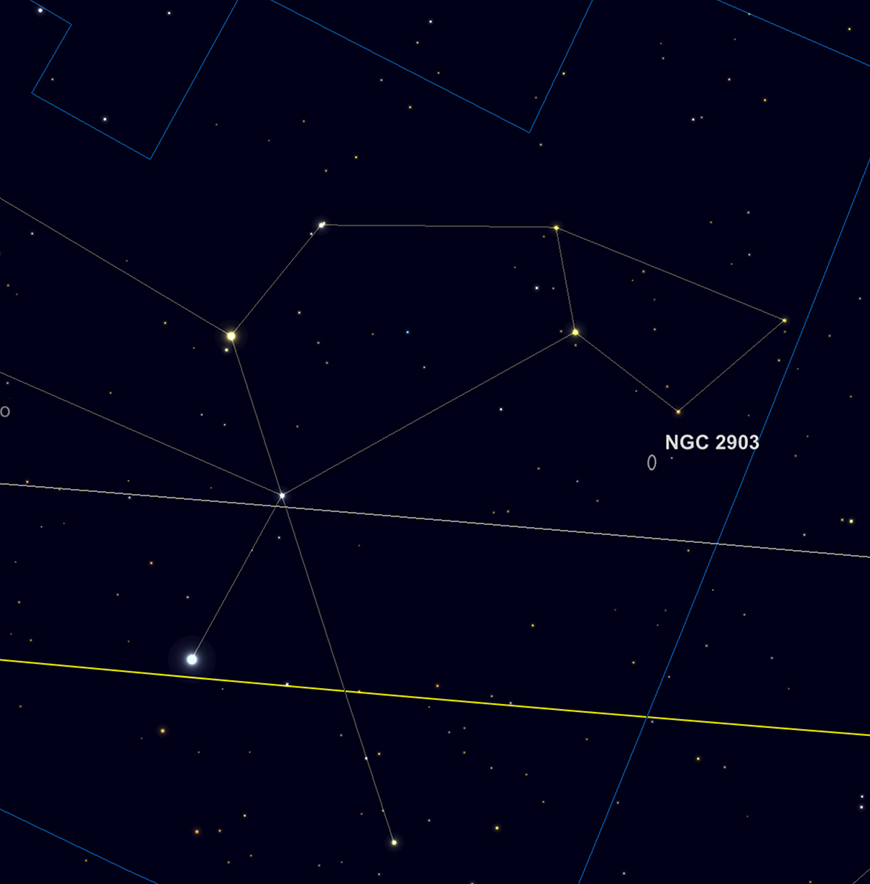
NGC2903 location - under the "chin" of Leo. Image created with SkySafari 5 for Mac OS X, ©2010-2016 Simulation Curriculum Corp., skysafariastronomy.com.
Sitting at a distance of 20.5 million light years, it is still fairly easy to see the dust lanes and emission nebulae. NGC 2905 is a prominent bright area in NGC 2903. NGC 2903 is thought to be about 80% as large as our own Milky Way Galaxy. The similarities continue with NGC2905's spiral structure and noticeable central bar. Hubble images show that NGC 2903's globular clusters seem somewhat brighter and more prominent than our Milky Way's globulars would be if viewed at a similar distance. This suggests they and their parent galaxy may be somewhat younger than our own.
NGC 2903 also appears very efficient in terms of star formation - its notable ring of material around its core being particularly rich in new stars. It is thought that the central bar's tidal forces are compressing this material and this is the driving mechanism behind this formation.
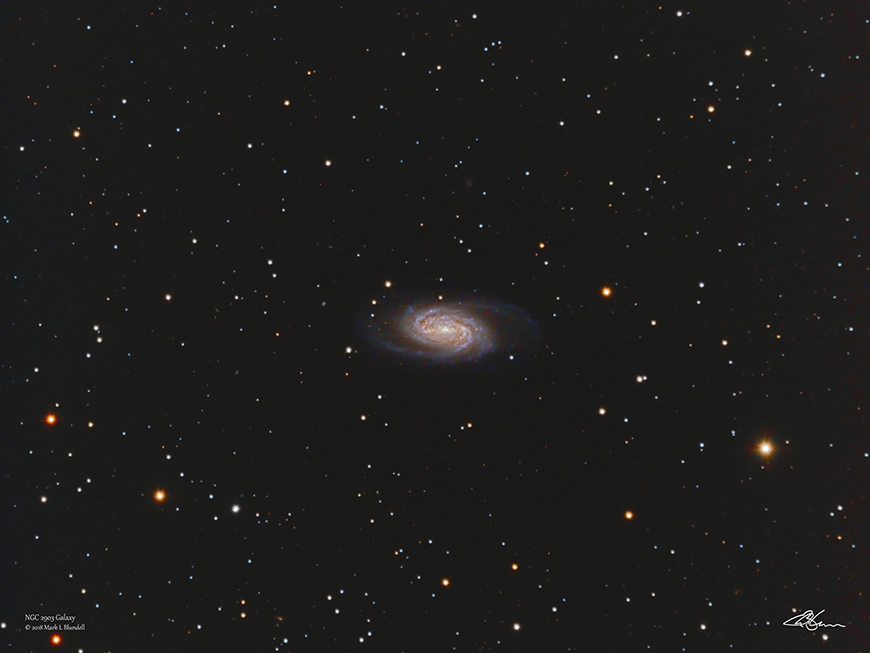
NGC 2903 by Mark Blundell. Image reproduced by kind permission.
Original text: Kerin Smith

 English
English
